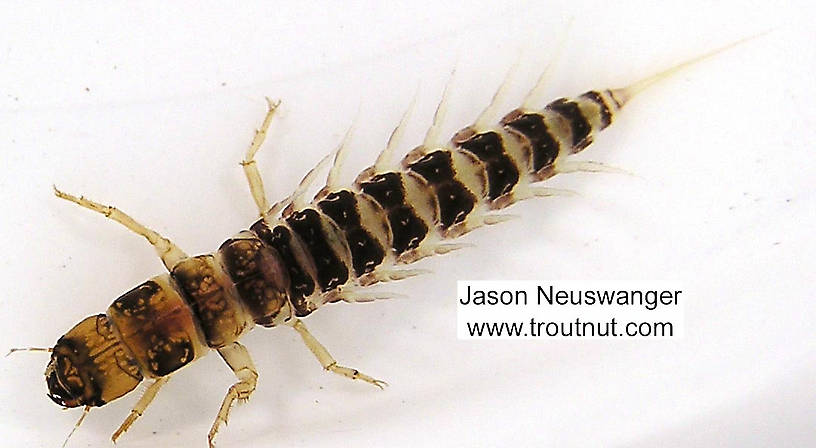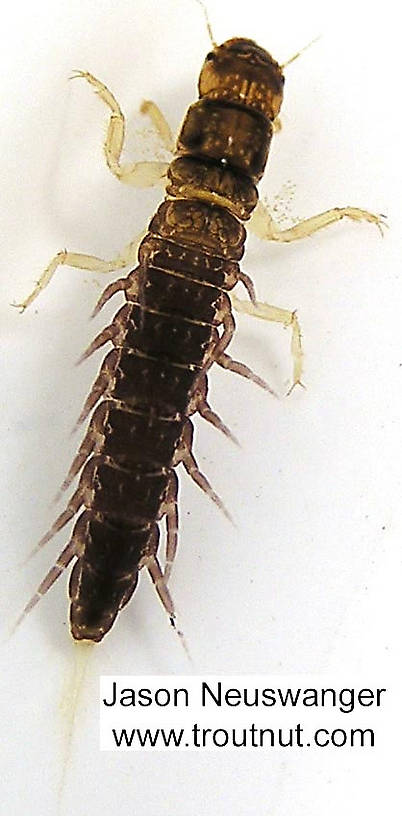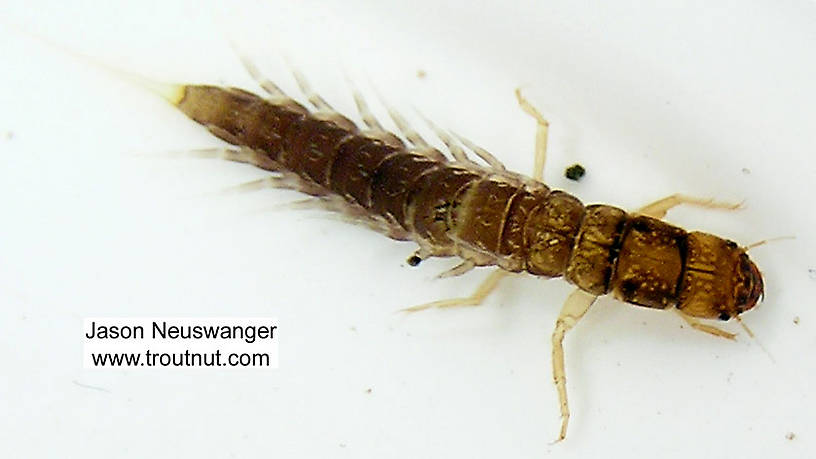
Salmonflies
Pteronarcys californica
The giant Salmonflies of the Western mountains are legendary for their proclivity to elicit consistent dry-fly action and ferocious strikes.
Featured on the forum

I caught this tiny larva without a case, but it seems to key pretty clearly to to Glossosomatidae. From there, the lack of sclerites on the mesonotum points to either Glossosoma or Anagapetus. Although it's difficult to see in a 2D image from the microscope, it's pretty clear in the live 3D view that the pronotum is only excised about 1/3 of its length to accommodate the forecoxa, not 2/3, which points to Glossosoma at Couplet 5 of the Key to Genera of Glossosomatidae Larvae.

Troutnut is a project started in 2003 by salmonid ecologist Jason "Troutnut" Neuswanger to help anglers and
fly tyers unabashedly embrace the entomological side of the sport. Learn more about Troutnut or
support the project for an enhanced experience here.
This topic is about the Insect Family Sialidae
See Sialis for details. It is the only genus of alderflies.Example specimens
Entoman on Jan 19, 2011January 19th, 2011, 8:07 pm EST
Sialids (Alder Flies) are fairly common In Northern California, Southern Oregon, and many other locations in the west as well. You will see them quite often in small numbers, less often in numbers of interest to the fish, and occasionally in numbers large enough that you better have a good imitation or you're in deep trouble. Forget about the larva and pupa. The larva live under a cover of detritus, crawl to shore undercover, and pupate terrestrially. It's the Adults that matter.
Sometimes it's hard to make out how many are actually in the swarm if you don't have good backlighting. My standing rule is: If the fish are rising and Alders are irritating the crap out of me, it's time to tie on an imitation. Anybody that's been in a serious fall of Alderflies knows what I mean by irritation! You'll want to move the boat... but don't. They really hate to fly, kind of like little black turkeys. A mayfly or midge will rest on you awhile and then fly off. A caddis my like to cover a little ground, but will usually fly off if you swat at him - if you ignore them they will usually just sit still. The same with stones. Alders on the other hand, are a different bread of cat. First, they don't land on you, they crash into you. Second, they'll run you up and down like a race horse on a fast track. Finally, swatting at them only makes them go faster and they will NOT fly off. The good news is they're totally harmless and the first 18 incher you hook up with will make you forget all about them. Don't use your hat to swat at them; especially if its a ball cap. Case in point - I remember a time getting into the car with a buddy after loading up the prams. I fired up the heater as he asked me a question. When I turned and opened my mouth to respond, I simultaneously took off my hat. Before I could utter a word a half dozen or so of the little devils ran down my face with a couple ending up in my mouth. My friend was laughing so hard, he ended up choking worse than me. On second thought, if you don't have a good imitation - move the boat.
There refusal to fly once landed is fascinating and it's amazing how fast they can run. I remember the time I was chasing one around in my pram trying to get a specimen for my collection. I'd trap it with my fingers delicately to avoid damage, but it always seemed to get away. Things got so frantic that I almost swamped the boat. A nearby buddy asked if I needed any help. He thought a mouse was loose.
I've had some great days over the years with Alderflies on a few mid-elevation west slope Sierra lakes, the spring fed waters of the Pit River drainage, and a host of small ponds and reservoirs in the foothill country east of Redding. When first encountered, I made the mistake of assuming they were caddis. Not that it mattered much as far as the fishing goes. Actually, they are pretty easy to tell from Caddis with their large heads, short antenna, and stocky bodies that reach much closer towards the ends of their wings. All in all, a much more substantial creature than any caddis of similar size. Now, they look as differentiated from caddis as dragonflies do from Hexigenia's. I smile when I think back to those simpler and unsophisticated years. Not that doubts about their identity didn't nag me. I looked into other possibilities, but this was back in the late 60's when the only descriptions in print described Alderflies as light brownish flies imitated with oak turkey quill. This ruled them out according to my way of thinking as ours are dark chocolate brown with sooty black wings. The gravid females have an under glow of burnt orange in the lower half of their abdomens (not unlike the shading you see in the big Pteronarcys stoneflies) that lightens them up a bit, but still they're mostly a very dark fly.
Contrary to conventional wisdom, I have always found them to be an excellent dry fly hatch when they're worth fishing at all. They're supposed to sink immediately upon contact with the water, but I have not found this to be so. I'm sure they probably drown fairly quickly, but time is a relative thing when fish are rising. On those rare occasions when the fall is heavy and the fish are into them, the right dry will usually bring up most of the rises cast over, so why go wet? No need to work this fly, just throw it out into the cruising lanes and let it sit for awhile. While they run like crazy on solid ground, they sit "stone still" on the water. I've tried a handful of different flies over the years, but never found one that works as well as the good old Troth's Elk Hair with the hackle trimmed underneath. the prominent head of trimmed hair simulates the look of the Sialids perfectly. Tie them bulky with a black body, brown palmered hackle, and Dk. moose body hair for the wing (works better than solid black). Keep the wing short to just beyond the bend. For sex appeal, I always add a little orange to the dubbing for the last third of the body to simulate the developing egg mass. Add it over the dubbing already on the thread, so this extra step doesn't add any time to the tying. It shouldn't look solid orange anyway. You'd think a closer matching Dk. brown body with black hackle and wing would work better, but the fish never agreed with me on that point. I only carry a half dozen or so, in the size I know I'll need for the area. Either #12, 2xl #12, or 2xl #10. If you're lucky (or unlucky) enough to be on the water when there's enough Alderflies to get the fish really going, you'll have a lot of fun with this fly.
Sometimes it's hard to make out how many are actually in the swarm if you don't have good backlighting. My standing rule is: If the fish are rising and Alders are irritating the crap out of me, it's time to tie on an imitation. Anybody that's been in a serious fall of Alderflies knows what I mean by irritation! You'll want to move the boat... but don't. They really hate to fly, kind of like little black turkeys. A mayfly or midge will rest on you awhile and then fly off. A caddis my like to cover a little ground, but will usually fly off if you swat at him - if you ignore them they will usually just sit still. The same with stones. Alders on the other hand, are a different bread of cat. First, they don't land on you, they crash into you. Second, they'll run you up and down like a race horse on a fast track. Finally, swatting at them only makes them go faster and they will NOT fly off. The good news is they're totally harmless and the first 18 incher you hook up with will make you forget all about them. Don't use your hat to swat at them; especially if its a ball cap. Case in point - I remember a time getting into the car with a buddy after loading up the prams. I fired up the heater as he asked me a question. When I turned and opened my mouth to respond, I simultaneously took off my hat. Before I could utter a word a half dozen or so of the little devils ran down my face with a couple ending up in my mouth. My friend was laughing so hard, he ended up choking worse than me. On second thought, if you don't have a good imitation - move the boat.
There refusal to fly once landed is fascinating and it's amazing how fast they can run. I remember the time I was chasing one around in my pram trying to get a specimen for my collection. I'd trap it with my fingers delicately to avoid damage, but it always seemed to get away. Things got so frantic that I almost swamped the boat. A nearby buddy asked if I needed any help. He thought a mouse was loose.
I've had some great days over the years with Alderflies on a few mid-elevation west slope Sierra lakes, the spring fed waters of the Pit River drainage, and a host of small ponds and reservoirs in the foothill country east of Redding. When first encountered, I made the mistake of assuming they were caddis. Not that it mattered much as far as the fishing goes. Actually, they are pretty easy to tell from Caddis with their large heads, short antenna, and stocky bodies that reach much closer towards the ends of their wings. All in all, a much more substantial creature than any caddis of similar size. Now, they look as differentiated from caddis as dragonflies do from Hexigenia's. I smile when I think back to those simpler and unsophisticated years. Not that doubts about their identity didn't nag me. I looked into other possibilities, but this was back in the late 60's when the only descriptions in print described Alderflies as light brownish flies imitated with oak turkey quill. This ruled them out according to my way of thinking as ours are dark chocolate brown with sooty black wings. The gravid females have an under glow of burnt orange in the lower half of their abdomens (not unlike the shading you see in the big Pteronarcys stoneflies) that lightens them up a bit, but still they're mostly a very dark fly.
Contrary to conventional wisdom, I have always found them to be an excellent dry fly hatch when they're worth fishing at all. They're supposed to sink immediately upon contact with the water, but I have not found this to be so. I'm sure they probably drown fairly quickly, but time is a relative thing when fish are rising. On those rare occasions when the fall is heavy and the fish are into them, the right dry will usually bring up most of the rises cast over, so why go wet? No need to work this fly, just throw it out into the cruising lanes and let it sit for awhile. While they run like crazy on solid ground, they sit "stone still" on the water. I've tried a handful of different flies over the years, but never found one that works as well as the good old Troth's Elk Hair with the hackle trimmed underneath. the prominent head of trimmed hair simulates the look of the Sialids perfectly. Tie them bulky with a black body, brown palmered hackle, and Dk. moose body hair for the wing (works better than solid black). Keep the wing short to just beyond the bend. For sex appeal, I always add a little orange to the dubbing for the last third of the body to simulate the developing egg mass. Add it over the dubbing already on the thread, so this extra step doesn't add any time to the tying. It shouldn't look solid orange anyway. You'd think a closer matching Dk. brown body with black hackle and wing would work better, but the fish never agreed with me on that point. I only carry a half dozen or so, in the size I know I'll need for the area. Either #12, 2xl #12, or 2xl #10. If you're lucky (or unlucky) enough to be on the water when there's enough Alderflies to get the fish really going, you'll have a lot of fun with this fly.
"It's not that I find fishing so important, it's just that I find all other endeavors of Man equally unimportant... And not nearly as much fun!" Robert Traver, Anatomy of a Fisherman
Taxon on Jan 19, 2011January 19th, 2011, 9:18 pm EST
Kurt-
Great info. You didn't mention the timing of the Alderfly emergence. It's an April or May event in WA. When does it happen in N. CA?
Great info. You didn't mention the timing of the Alderfly emergence. It's an April or May event in WA. When does it happen in N. CA?
PaulRoberts on Jan 20, 2011January 20th, 2011, 3:27 am EST
I fished a Sialis larva imitation during winter back in NY. I did so after I began finding larvae in trout stomachs then, and even pumped some so fresh they bit me! The fish came from the basins of deep slow wintering pools.
I saw but never fished Sialid adults. Some places had them in good numbers. We have a small (~#10) black cicada here (CO) that reminds me of them quite a bit, and I've fished a dry imitation for the cicadas. Easy to know when they are about and abundance as they make a sharp 'click' for a call.
I saw but never fished Sialid adults. Some places had them in good numbers. We have a small (~#10) black cicada here (CO) that reminds me of them quite a bit, and I've fished a dry imitation for the cicadas. Easy to know when they are about and abundance as they make a sharp 'click' for a call.
Entoman on Jan 20, 2011January 20th, 2011, 5:24 am EST
Hi Roger,
You're right! Sorry for the omission. Sialid emergence dates depend on elevation. I've fished over them as early as March/early April on some low El. mountain ponds East of the North Valley (Redding) area (BTW - that's where the big boys are, 2X long #10!), mid May(ish) on Fall River and as late as mid June above 5,000 ft in the Sierras. Like a lot of insect activity, there is some variation depending on the year, and many years where they failed to appear at all for that matter (at least for me). They tend to be an evening fall, but I have also seen fishable situations midday early in the year. Never seen them in inclement conditions, but soft overcast days can be pretty good if it isn't too cold. Another curious note: The small ones are found high or North and the large ones low.
Regards,
Kurt
You're right! Sorry for the omission. Sialid emergence dates depend on elevation. I've fished over them as early as March/early April on some low El. mountain ponds East of the North Valley (Redding) area (BTW - that's where the big boys are, 2X long #10!), mid May(ish) on Fall River and as late as mid June above 5,000 ft in the Sierras. Like a lot of insect activity, there is some variation depending on the year, and many years where they failed to appear at all for that matter (at least for me). They tend to be an evening fall, but I have also seen fishable situations midday early in the year. Never seen them in inclement conditions, but soft overcast days can be pretty good if it isn't too cold. Another curious note: The small ones are found high or North and the large ones low.
Regards,
Kurt
"It's not that I find fishing so important, it's just that I find all other endeavors of Man equally unimportant... And not nearly as much fun!" Robert Traver, Anatomy of a Fisherman
Taxon on Jan 20, 2011January 20th, 2011, 7:12 am EST
Kurt-
Interesting stuff. The only time I've actually encountered adult alderflies was the day before opening of fishing season (late April) on a lake in E. WA about 30 years ago. My fishing partner and I were walking along the shoreline of the lake to scout out where we might want to fish the following morning, and came upon a small deciduous tree overhanging the water, which was laden with the adults, a few being within easy reach. This was before I knew diddly-squat about aquatic insects, so I had no idea what they were. However, I was able to collect several, and upon arrival home a few days later, was able to identify them from a book (Western Hatches by Hafele and Hughes), which I had recently purchased in a second-hand bookstore, but not yet studied to any great extent. Darn, if only I could recall yesterday as clearly.
Interesting stuff. The only time I've actually encountered adult alderflies was the day before opening of fishing season (late April) on a lake in E. WA about 30 years ago. My fishing partner and I were walking along the shoreline of the lake to scout out where we might want to fish the following morning, and came upon a small deciduous tree overhanging the water, which was laden with the adults, a few being within easy reach. This was before I knew diddly-squat about aquatic insects, so I had no idea what they were. However, I was able to collect several, and upon arrival home a few days later, was able to identify them from a book (Western Hatches by Hafele and Hughes), which I had recently purchased in a second-hand bookstore, but not yet studied to any great extent. Darn, if only I could recall yesterday as clearly.
Entoman on Jan 20, 2011January 20th, 2011, 7:12 am EST
Hi Paul,
So you've been bit by a Sialid? Like my Grandpa used to say when I'd skin my knee or something, "It can't hurt that bad... I didn't feel it!' ha ha. I've dredged the muck in lakes where I've had some wild experiences with this hatch and always found them in pretty good numbers if done at the right time of year (along with a fair amount of other nasty looking critters). Never been bit by one (probably because I was too afraid to handle them without tweezers), but they sure look like they could do some damage. It's a good thing the adults aren't similarly equipped or it would be the end of all life within a ten mile radius of their emergence sights!
Your experience may explain the success of small Wooly Buggers, Carey Specials, Sheep Creeks, and a host of other suggestive patterns dredged around during non-hatch periods in my neck of the woods. Still, I'm pretty sure that any predation on Sialid larva is more opportunistic than selective as they share the same habitat with a lot of different life forms including various Beetle larva, dragonfly nymphs, caddis larvae, and others; many of them far more available. They may be more exposed as they migrate to shore for pupation, but I've never found evidence of it. They stay pretty deep in the muck. Perhaps they engage in some sort of mass benthic relocation akin to behavioral drift exhibited by many species in lotic environments? Hard to verify without an insane amount of underwater camera work. There's nothing like being in the right place at the right time.
Back in the day before catch and release, I saw to it that I was in charge of fish cleaning duties in my circle of buds. I'd even drive over to their houses if I wasn't on the trip. I think they found it humorous the hours I'd spend hunched over a white tray fooling around with fish entrails, but I was pretty anal about it. Out of all those autopsies (and there were more than I care to admit), excepting dragonfly nymphs and caddis, I don't remember ever finding more than a few from the toothy category, and even that was very rare. Just goes to show there are definitely regional differences. Do you think your experience is very common back there?
So you've been bit by a Sialid? Like my Grandpa used to say when I'd skin my knee or something, "It can't hurt that bad... I didn't feel it!' ha ha. I've dredged the muck in lakes where I've had some wild experiences with this hatch and always found them in pretty good numbers if done at the right time of year (along with a fair amount of other nasty looking critters). Never been bit by one (probably because I was too afraid to handle them without tweezers), but they sure look like they could do some damage. It's a good thing the adults aren't similarly equipped or it would be the end of all life within a ten mile radius of their emergence sights!
Your experience may explain the success of small Wooly Buggers, Carey Specials, Sheep Creeks, and a host of other suggestive patterns dredged around during non-hatch periods in my neck of the woods. Still, I'm pretty sure that any predation on Sialid larva is more opportunistic than selective as they share the same habitat with a lot of different life forms including various Beetle larva, dragonfly nymphs, caddis larvae, and others; many of them far more available. They may be more exposed as they migrate to shore for pupation, but I've never found evidence of it. They stay pretty deep in the muck. Perhaps they engage in some sort of mass benthic relocation akin to behavioral drift exhibited by many species in lotic environments? Hard to verify without an insane amount of underwater camera work. There's nothing like being in the right place at the right time.
Back in the day before catch and release, I saw to it that I was in charge of fish cleaning duties in my circle of buds. I'd even drive over to their houses if I wasn't on the trip. I think they found it humorous the hours I'd spend hunched over a white tray fooling around with fish entrails, but I was pretty anal about it. Out of all those autopsies (and there were more than I care to admit), excepting dragonfly nymphs and caddis, I don't remember ever finding more than a few from the toothy category, and even that was very rare. Just goes to show there are definitely regional differences. Do you think your experience is very common back there?
"It's not that I find fishing so important, it's just that I find all other endeavors of Man equally unimportant... And not nearly as much fun!" Robert Traver, Anatomy of a Fisherman
Entoman on Jan 20, 2011January 20th, 2011, 7:57 am EST
Roger,
Ha! Hafele's book is what finally solved the Sialid puzzle for me! Back in those years I was pretty entomologically challenged and couldn't tell you the difference between a Maxillary pulpus and a Tarsi, so taxonomic keys weren't very helpful. I remember paging through it in a fly shop when it first came out. The photographs and color descriptions of the Alderfly leapt out at me. I remember saying out loud, "There you are, you little ...(expletive deleted)!", much to the surprise of fellow shoppers. I bought it on the spot. Loved the large margins. They are filled with the recipes of favorite flies in pencil, erased and replaced many times over the years before computer files and the internet. Though I wasn't particularly impressed with most of the fly patterns, it was (along with Arbona's Mayflies... and Schwiebert's Nymphs) both ento bible and fly design help all through the 80's for me.
Kurt
Ha! Hafele's book is what finally solved the Sialid puzzle for me! Back in those years I was pretty entomologically challenged and couldn't tell you the difference between a Maxillary pulpus and a Tarsi, so taxonomic keys weren't very helpful. I remember paging through it in a fly shop when it first came out. The photographs and color descriptions of the Alderfly leapt out at me. I remember saying out loud, "There you are, you little ...(expletive deleted)!", much to the surprise of fellow shoppers. I bought it on the spot. Loved the large margins. They are filled with the recipes of favorite flies in pencil, erased and replaced many times over the years before computer files and the internet. Though I wasn't particularly impressed with most of the fly patterns, it was (along with Arbona's Mayflies... and Schwiebert's Nymphs) both ento bible and fly design help all through the 80's for me.
Kurt
"It's not that I find fishing so important, it's just that I find all other endeavors of Man equally unimportant... And not nearly as much fun!" Robert Traver, Anatomy of a Fisherman
Gutcutter on Jan 20, 2011January 20th, 2011, 8:40 am EST
i once prescribed a cialis imitation for spence.
he told me it didn't work. huh...maybe because it was blue and had a "V" on it and not black with some marabou..
he told me it didn't work. huh...maybe because it was blue and had a "V" on it and not black with some marabou..
All men who fish may in turn be divided into two parts: those who fish for trout and those who don't. Trout fishermen are a race apart: they are a dedicated crew- indolent, improvident, and quietly mad.
-Robert Traver, Trout Madness
-Robert Traver, Trout Madness
Taxon on Jan 20, 2011January 20th, 2011, 11:28 am EST
Antonio!!! Now behave yourself!!!
Quick Reply
Related Discussions
Topic
Replies
Last Reply
Brachycentrus americanus on the Lower Sacramento River California
In the Caddisfly Species Brachycentrus americanus by Troutguide
In the Caddisfly Species Brachycentrus americanus by Troutguide
0
Oct 29, 2016
by Troutguide
by Troutguide
0
May 6, 2011
by Jtberez
by Jtberez









